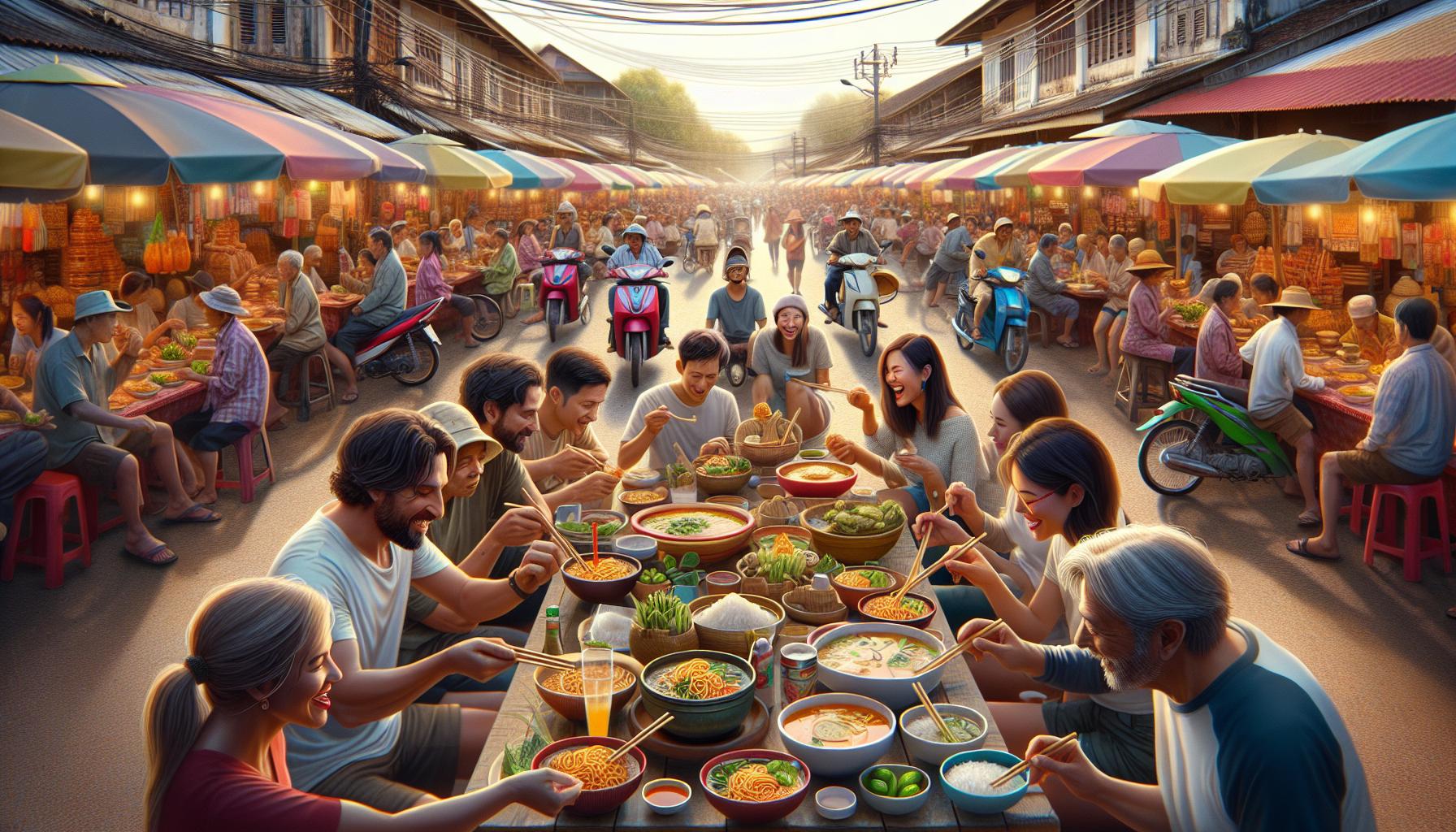Physical Address
304 North Cardinal St.
Dorchester Center, MA 02124
Physical Address
304 North Cardinal St.
Dorchester Center, MA 02124

Planning a trip to Laos doesn’t have to break the bank. This laid-back Southeast Asian gem offers travelers an authentic experience at surprisingly affordable prices. From the mystical temples of Luang Prabang to the stunning landscapes of Vang Vieng travelers can explore this enchanting country without emptying their wallets.
Whether backpacking on a shoestring budget or seeking mid-range comfort Laos accommodates all types of travelers. With comfortable guesthouses starting at $10 per night delicious street food for under $5 and local transportation that won’t strain the budget it’s possible to experience the magic of Laos for as little as $30 per day. The country’s relaxed atmosphere rich culture and friendly locals make it an ideal destination for budget-conscious adventurers looking to stretch their travel dollars further.
Daily travel costs in Laos range from $30-$125 depending on accommodation choices travel style. Here’s a detailed breakdown of expenses:
| Meal Type | Cost Range |
|---|---|
| Street food | $2-5 |
| Local restaurant | $5-10 |
| Western restaurant | $8-20 |
| Beer (local) | $1-2 |
| Coffee | $1-3 |
The cost of traveling in Laos increases during peak season (November to March). Prices in popular tourist destinations like Luang Prabang Vientiane rise 20-30% compared to off-peak rates. Budget travelers spend $30-40 daily while mid-range tourists allocate $50-80 for comfortable accommodations upgraded dining options additional activities.

The cost of living in Laos varies based on travel style preferences. Here’s a detailed breakdown of expenses across key categories.
Guesthouses offer basic rooms with fans starting at $10 per night in cities like Vang Vieng Luang Prabang. Mid-range hotels with air conditioning swimming pools cost $25 to $45 nightly. Boutique hotels provide upscale amenities including breakfast room service at $80 to $200 per night. Private rooms in hostels average $15 while dormitory beds cost $5 to $8. Premium resorts near tourist attractions charge $150 to $300 during peak season from November through March.
Street food vendors sell local dishes like noodle soups sticky rice for $2 to $5 per meal. Local restaurants charge $5 to $10 for traditional Lao cuisine including laap tam mak hoong. Western restaurants serve international dishes at $8 to $20 per person. Fresh fruit smoothies cost $1 to $2 while local Beer Lao runs $1 to $3 per bottle. Coffee shops charge $2 to $4 for beverages snacks. Night markets offer complete meals for $3 to $6.
Tuk-tuks charge $2 to $5 for short trips within cities. Local buses cost $0.50 to $2 per ride. Inter-city buses range from $10 for basic service to $20 for VIP coaches. Bicycle rentals cost $2 to $5 daily while motorbike rentals average $8 to $15 per day. Private car hires with drivers charge $50 to $80 daily. River boats between towns cost $15 to $25 per journey. Airport transfers run $5 to $15 depending on distance location.
Timing a trip to Laos impacts both travel costs and experience quality. The country’s distinct seasons create significant price variations throughout the year.
Peak season in Laos runs from November to March, with accommodation prices increasing 20-30%. High-end hotels in Luang Prabang charge $150-200 per night during this period compared to $80-120 in off-peak months. Budget guesthouses raise rates from $10 to $15-20 during peak season. Popular attractions like the Kuang Si Falls increase entrance fees from $2.50 to $3.50. Transportation costs rise with tuk-tuk drivers charging $5 for rides that cost $3 in low season. The shoulder season (October and April) offers moderate prices with guesthouses averaging $12-15 per night.
The dry season spans November to April with temperatures between 59-95°F (15-35°C). December and January bring cool mornings at 59°F (15°C) and comfortable afternoons. The wet season occurs from May to October with rainfall averaging 7-14 inches per month. September receives the most precipitation at 14 inches. Morning temperatures during wet season stay around 75°F (24°C) with afternoon highs reaching 90°F (32°C). October marks a transition month with decreasing rainfall and pleasant temperatures between 70-85°F (21-29°C).
Maximizing a travel budget in Laos involves understanding local pricing dynamics. These practical strategies help travelers stretch their money while experiencing authentic Laotian culture.
Laos operates on a dual pricing system where locals pay significantly less than tourists. Tourist prices for attractions like temples range from $2-5 while locals pay $0.50-1. Transportation shows similar differences with locals paying $0.30 for tuk-tuk rides that cost tourists $2-3. Markets charge tourists 30-50% more for items like fruit drinks bottled water. Identifying local markets street food stalls restaurants reduces costs by 40-60%. Shopping at morning markets where locals buy groceries yields better prices than tourist-oriented night markets. Local food courts in smaller towns offer meals at $1-2 compared to $5-8 in tourist areas.
Bargaining is common practice in Laos markets transportation services. Starting prices decrease 30-40% through negotiation at markets. Tuk-tuk drivers accept 50% less than initial quotes for short trips. Room rates at guesthouses drop 15-20% for stays longer than 3 nights. Group purchases at markets earn 20-25% discounts. Morning market vendors offer better deals than afternoon sellers. Multi-day tour packages include 25-30% discounts when booked directly with local operators. Combining services like transportation accommodation leads to package savings of 15-20%. Speaking basic Lao phrases during negotiations results in better prices.
Understanding specific budget breakdowns helps travelers plan their Laos trip effectively based on different comfort levels and spending preferences. Here’s a detailed look at two common travel styles.
Backpackers in Laos spend $30-40 per day for basic accommodations and local experiences. A typical daily budget breaks down to $10-15 for dormitory beds or basic guesthouses, $8-12 for street food and local restaurants, $5-8 for transportation via tuk-tuks or local buses, plus $5-7 for activities and temple entrance fees. Budget travelers stay in hostels with shared bathrooms, eat at night markets, use local transportation, and visit free attractions like temples and markets. Backpackers save money by booking directly with guesthouses, sharing transportation costs with other travelers, and preparing simple meals at hostel kitchens when available.
Mid-range travelers allocate $60-100 daily for enhanced comfort and experiences. The daily breakdown includes $25-45 for private rooms in boutique hotels with air conditioning and private bathrooms, $15-25 for meals at mid-range restaurants, $10-15 for transportation using private tuk-tuks or rental motorbikes, plus $10-15 for guided tours and activities. These travelers enjoy comfortable accommodations with reliable WiFi, dine at restaurants serving both local and international cuisine, take organized day tours to attractions like Kuang Si Falls, and experience traditional spa treatments. Mid-range travelers benefit from hotel amenities including breakfast buffets, swimming pools, and concierge services.
The official currency in Laos is the Lao Kip (LAK), with exchange rates averaging 17,000 LAK to 1 USD. US dollars serve as an alternative currency, accepted at major hotels, restaurants and tourist attractions in cities like Luang Prabang and Vientiane.
Cash transactions dominate the Laotian economy, particularly in smaller towns and local markets. ATMs dispense both US dollars and Lao Kip, available in major tourist areas with withdrawal limits of 1,000,000 to 2,000,000 LAK per transaction.
| Payment Method | Availability | Usage |
|---|---|---|
| Cash (LAK/USD) | Widespread | Markets, local shops, transportation |
| Credit Cards | Limited | High-end hotels, restaurants |
| Mobile Payments | Growing | Select urban businesses |
Credit card acceptance remains limited to upscale establishments, with Visa and Mastercard being the most widely accepted. Transaction fees range from 3% to 5% at establishments that accept cards.
Common banknotes include:
Money exchange services operate in tourist areas, hotels and banks, offering varying rates. Local banks provide better exchange rates compared to tourist-oriented currency exchanges, with rate differences of up to 2%.
Smart travelers exchange money at official banks or licensed money changers, avoiding street vendors who often offer fraudulent rates. Keeping smaller denominations proves essential for daily transactions in markets and local transportation.
Traveling to Laos offers an incredible blend of cultural richness and affordability. Whether choosing budget-friendly guesthouses or mid-range hotels travelers can create memorable experiences without breaking the bank. With daily expenses ranging from $30 for budget travelers to $100 for those seeking more comfort there’s a perfect fit for every style of travel.
Smart planning around seasonal pricing and local payment methods helps maximize the value of every dollar spent. By embracing local markets negotiating prices and exploring during shoulder seasons visitors can unlock even better deals while experiencing the authentic charm of this Southeast Asian gem.